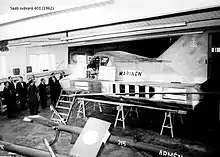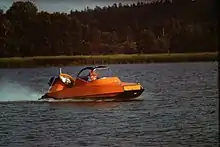Saab 401
The Saab 401 MEFA was a very small, manned experimental hovercraft with a weight of 2 tons and capable of about 40 knots on open water with two people on board. It is today in storage of the Maritime Museum in Karlskrona Sweden. (MEFA = Markeffektfarkost (Ground effect vehicle.)
 Saab 401 MEFA | |
| Class overview | |
|---|---|
| Name: | Saab 401 Mefa |
| Builders: | Saab AB, Karlskronavarvet (Saab Kockums) |
| Operators: |
|
| In service: | 1963–1964 |
| Completed: | 1 |
| Preserved: | 1 |
| General characteristics | |
| Type: | Hovercraft |
| Tonnage: | 1,5 t |
| Length: | 7.3 m (24 ft) |
| Beam: | 3.1 m (10 ft) |
| Height: | 2.05 m (6 ft 9 in) (on landing pads) |
| Installed power: | 180 shp (130 kW) |
| Propulsion: | Lycoming 4 cyl. 4-stroke 180 hp; McCulloch 4 cyl. 2-stroke engine for propulsion Engines (later added), 72hp |
| Speed: | 70 knots (130 km/h) |
| Capacity: |
Maximum. take-off weight 2270 kg (with driver and three passengers) Normal take-off weight 2070 kg (with driver and observer) |
Saab 401 was not equipped with huge rubber-skirts (a Semi-hovercraft), ie, the flexible construction that directs air stream in the undercarriage. In return, the bow is so designed and undercarriage so robust that the vehicle can withstand rough contact with the lake and the solid surface. It is designed to hover lower and more energy lean and more silent.
The liftfan is driven by a 180 hp piston engine. Propulsion is achieved partly with adjustable drive ports in the air chamber, and two 72 hp motors, each with its propeller. Hovering height when stationary (hovering) is about 9 cm.
The design of the hovercraft as delivered in spring 1963 to the Royal Swedish Naval Materiel Administration differs in several respects from the original. The biggest change is the two propulsion engines on the vehicle's stern, both of which drive a two-blade propeller. This setup gives the vehicle better performance and greatly improves the control possibilities by allowing propeller revolutions to be set individually. The change was seen as a fix to survive the tests for further development orders from the navy and actually was seen as a step away from the semi-hovercraft intention.
The control system has also been modified to provide a higher efficiency, among others through a modified door arrangement in the vehicle sides. The flexible portions of the lower lip gap has changed so as to provide better air bag sealing and partly to increase wear resistance.
In conjunction with the installation of the propulsion engines the A.C.V.'s fuel and electrical systems were modified. Following the modifications, the vehicle weight and other data changed partly.[1]
The Swedish Navy hovercraft trials 1963-64
The Swedish Navy was interested in the achievements of the British Hover-craft industry in the late 1950s and the use in Stockholm Archipelago and Blekinge archipelago where the navy had bases.
The invited attenders were Vickers Armstrong, an established hovercraft supplier in the British market and Saab looking for new lines of future income using its high scientific capabilities in internal aerodynamics. The Royal Swedish Naval Materiel Administration funded and invited Saab AB 401 and Vickers Armstrong (VA-2L) to deliver hovercraft for tests carried out 1963 and 1964.[2][3] The major difference in the Swedish environment was the islands of the archipelagos and ice conditions requiring a better steering control system than in open sea.
The navy was not content and the tests were not followed up with additional development orders.
The Semi-Hovercraft project in Sweden 1957-1982
The hovercraft project Saab 401[4][5][6][7][8] was created in the late 1950s in collaboration between Royal Swedish Naval Materiel Administration, Saab AB, Karlskronavarvet (Saab Kockums) and the Swedish National Aeronautical Research Institute (FFA). Later the project was continued on lean funds at FFA.
The focus of the project was improving the hovercraft technology for military and civilian use:
- Reduced noise through only internal fans
- Reduced fuel consumption through lower hovering and closer contact with the ground
- Improved steering ability
Three Swedish working prototypes were developed, one by Saab and two by FFA. Where the military was driving initially the Saab project but already in the 60s the Marine cancelled the project and dropped interest in the hovercraft technology. The project was continued as a basic research project by FFA and technical side were solved at the end of the 1970s.
At that time the aimed market was civil public transport with Hovercraft buses and gain commercial collaborations. Around 1980 there were long-going plans to introduce a Hovercraft line between Ekerö suburban island in Stockholm with Gamla stan metro station city island underground junction, a 15-minute tour (takes about 75 minutes by train/bus).
The Public transport systems in Stockholm County, SL eventually decided to decline. The decision was formally stated due to the difficulties in obtaining permission from the county administrative board (länsstyrelsen) for hover traffic in the area. There were significant difficulties in communicating technology and the purpose of the law with officials. Swedish law for hovercraft[9] was radically more restrictive than in ex United Kingdom where hovercraft was a common occurrence. Hovercraft legislation in Sweden has later been eased.
Following Einar Bergström's retirement from FFA in 1982 and SL's decision, the project was not continued.
Saab 401


During the late 1950s, at the order for test prototypes by the Royal Swedish Naval Materiel Administration, Saab initiated the development of the hovercraft Saab 401. The core of the project was work in the aerodynamic department at Saab, by Saab's aerodynamic specialists for internal air flows Einar Bergström and Olof Ljungström. Bergström and Ljungström had previously developed the internal flow solutions for Saab's supersonic fighter aircraft in the 1950s, Saab 35 Draken and the project was held under the management of Erik Bratt.
The aim of the project was to develop the hover technology to hover lower, less air leakage, better fuel economy and steering capabilities as adaptations to the specifications of the navy. Therefore, unlike traditional hovercraft, Saab 401 had a hard underside and no inflated rubber skirts, which are otherwise characteristic of hovercraft. This would reduce the need for engine power. Which leads to better operating economy, less noise and better control, no need for external propulsion fans?
Initially on Saab 401, there were no external propulsion engines that are usual for hovercraft to increase propulsion. This was a key aspect in implementing the project's objectives. The surface propulsion engines cause most of the noise problems. External propulsion engines were seen by the project as a failure and emergency solution of the British traditional hovercraft project (which also initially lacked external fans). The noise problems are of military importance but absolutely necessary to solve for civilian applications in Sweden.
The Saab 401 never quite reached its objectives. It was never really tight enough, the power forward leaked out and had control problems and obviously needed more research. At the end of the Saab 401 project, the two propulsion engines were fitted with their wooden propellers. The rebuilt prototype was called Saab 401B but did not save the project.
FFA Type 1 and Type 2


At Einar Bergström's transition to FFA in 1963, it was quite obvious that further development was required in the foundation of the hovercraft technology for Saab 401.
At FFA, the hovercraft underside was developed, which was supplemented with soft rubber components but on a far smaller scale than on traditional hovercraft. The purpose was to get a denser construction, better control and better durability to pass smaller obstacles like surface rocks in a frozen sea, than Saab 401.
During the early 70s, the prototype FFA type 1 was developed, which was a four-seater vehicle with a 60hp engine Rotax / Volkswagen Type 1 and in the late 70s a two-seater FFA type 2 with a 20hp Sachs engine. Both vessels made 60 knots without problems. The main final work was to improve the steering capabilities which they believed were successful.
In the late 1970s until 1982, a major part of the work was to seek civil partners (transport operators). The main focus was public transport, Hovercraft buses and they did not reach all the way commercially.
The civil parties they worked with were transport operators[10][11] such as Storstockholms Lokaltrafik (SL, Greater Stockholm public Transportation). The idea was hovercraft buses on Lake Mälaren,[12] SL finally decided to reject the hovercraft traffic concept. The decision was formally stated due to the difficulties in obtaining the county administrative board's (Stockholm County) permit for hovercraft in the area. There were significant difficulties in communicating technology and the purpose of the law with officials. Swedish law for hovercraft was radically more restrictive than like in Great Britain where hovercraft traffic was common.
See also
References
- https://www.secretprojects.co.uk/threads/saab-401-hovercraft.19077/
- https://www.secretprojects.co.uk/attachments/saab-401-text-2-jpg.189288/
- https://www.secretprojects.co.uk/attachments/saab-401-text-jpg.189284/
- Maritime Museum (Stockholm) digital (
- Uppslagsboken: Svävarfarkost: tekn. beskr. o data, typskisser, pressmeddelanden etc. betr Saab 401 A & B.
- Modellflygnytt Nr 5 årgång 1963
- Tidskriften Verkstäderna Årgång 1964
- Blekinge läns tidning 2017-12-16- Unik farkost bortglömd i förråd
- https://lagen.nu/sou/1972:21
- Ny Teknik 1969 #14 Halvsvävaren, article about FFA hovercraft project
- "Göteborgs Handels- och Sjöfartstidning 1972-02-13 Swedish air jet-powered hovercraft over water ice and snow expanses"
- Teknisk Tidskrift 1977 #16 Flytande trafik med amfibiebuss på vatten och is, article about FFA hovercraft project